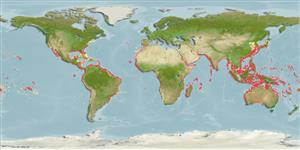>
Carangiformes (Jacks) >
Carangidae (Jacks and pompanos) > Caranginae
Etymology: Alectis: One of three Erinyes in the Greek mythology; daughter of Acheronte with a terrible rage.
More on author: Bloch.
Environment: milieu / climate zone / intervalo de profundidade / distribution range
Ecologia
marinhas associadas(os) a recifes; intervalo de profundidade 60 - 100 m (Ref. 37816). Subtropical; 42°N - 34°S, 180°W - 180°E
Circumglobal in tropical, subtropical and temperate seas. Western Atlantic: Massachusetts, USA and Bermuda to Santos, Brazil; throughout the Caribbean Sea and the Gulf of Mexico (Ref. 9626). Eastern Atlantic: Senegal to Congo. Western Indian Ocean: Red Sea to Algoa Bay, South Africa and to Sri Lanka (Ref. 3197, 3287). Eastern Pacific: Mexico to Peru.
Tamanho / Peso / Idade
Maturidade: Lm ? range ? - ? cm
Max length : 150 cm TL macho/indeterminado; (Ref. 30573); common length : 100.0 cm FL macho/indeterminado; (Ref. 30573); peso máx. Publicado: 22.9 kg (Ref. 40637)
Espinhos dorsais (total) : 7 - 8; Raios dorsais moles (total) : 18 - 22; Espinhos anais: 3; Raios anais moles: 15 - 20.
Body shape (shape guide): short and / or deep; Cross section: compressed.
Pelagic in neritic and oceanic waters, sometimes near the bottom (Ref. 5217, 58302). Small juveniles may be found near the shore (Ref. 5217); adults near bottom to depths of 60 m (Ref. 26938). Feed on sedentary or slow moving crustaceans and occasionally feed on small crabs and fishes (Ref. 9283). Juveniles are attractive aquarium fish, but do not do well in captivity (Ref. 12484). Excellent food fish (Ref. 9626); marketed fresh or dried or salted (Ref. 9283).
Life cycle and mating behavior
Maturidade | Reprodução | Desova | Ovos | Fecundidade | Larvas
Paxton, J.R., D.F. Hoese, G.R. Allen and J.E. Hanley, 1989. Pisces. Petromyzontidae to Carangidae. Zoological Catalogue of Australia, Vol. 7. Australian Government Publishing Service, Canberra, 665 p. (Ref. 7300)
Categoria na Lista Vermelha da IUCN (Ref. 130435: Version 2025-1)
Ameaça para o homem
Reports of ciguatera poisoning (Ref. 31174)
Utilização humana
Pescarias: pouco comercial; peixe desportivo: sim; Aquário: Espécies comerciais
Ferramentas
Relatórios especiais
Descarregue XML
Fontes da internet
Estimates based on models
Preferred temperature (Ref.
123201): 16.4 - 27.8, mean 24.8 °C (based on 400 cells).
Phylogenetic diversity index (Ref.
82804): PD
50 = 1.0000 [Uniqueness, from 0.5 = low to 2.0 = high].
Bayesian length-weight: a=0.02239 (0.01363 - 0.03678), b=2.84 (2.70 - 2.98), in cm total length, based on LWR estimates for this species & (Sub)family-body (Ref.
93245).
Nível Trófico (Ref.
69278): 4.0 ±0.7 se; based on diet studies.
Resiliência (Ref.
120179): Baixo, tempo mínimo de duplicação da população 4,5 - 14 anos (Preliminary K or Fecundity.).
Prior r = 0.28, 95% CL = 0.19 - 0.42, Based on 1 data-limited stock assessment.
Fishing Vulnerability (Ref.
59153): Very high vulnerability (90 of 100).
🛈
Nutrients (Ref.
124155): Calcium = 16.6 [6.6, 29.7] mg/100g; Iron = 0.599 [0.316, 1.256] mg/100g; Protein = 20 [19, 21] %; Omega3 = 0.15 [0.08, 0.29] g/100g; Selenium = 24.9 [9.7, 53.5] μg/100g; VitaminA = 22.8 [5.7, 87.4] μg/100g; Zinc = 0.403 [0.255, 0.614] mg/100g (wet weight);
